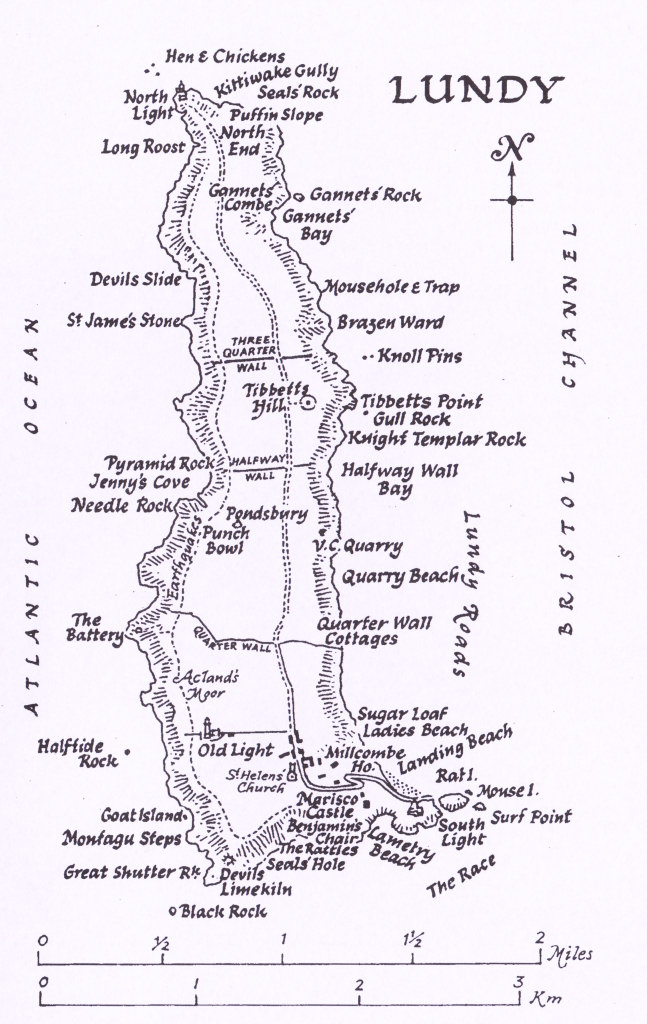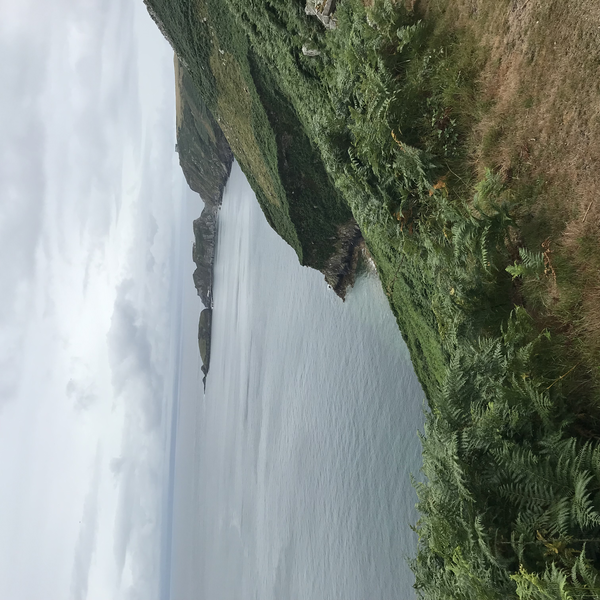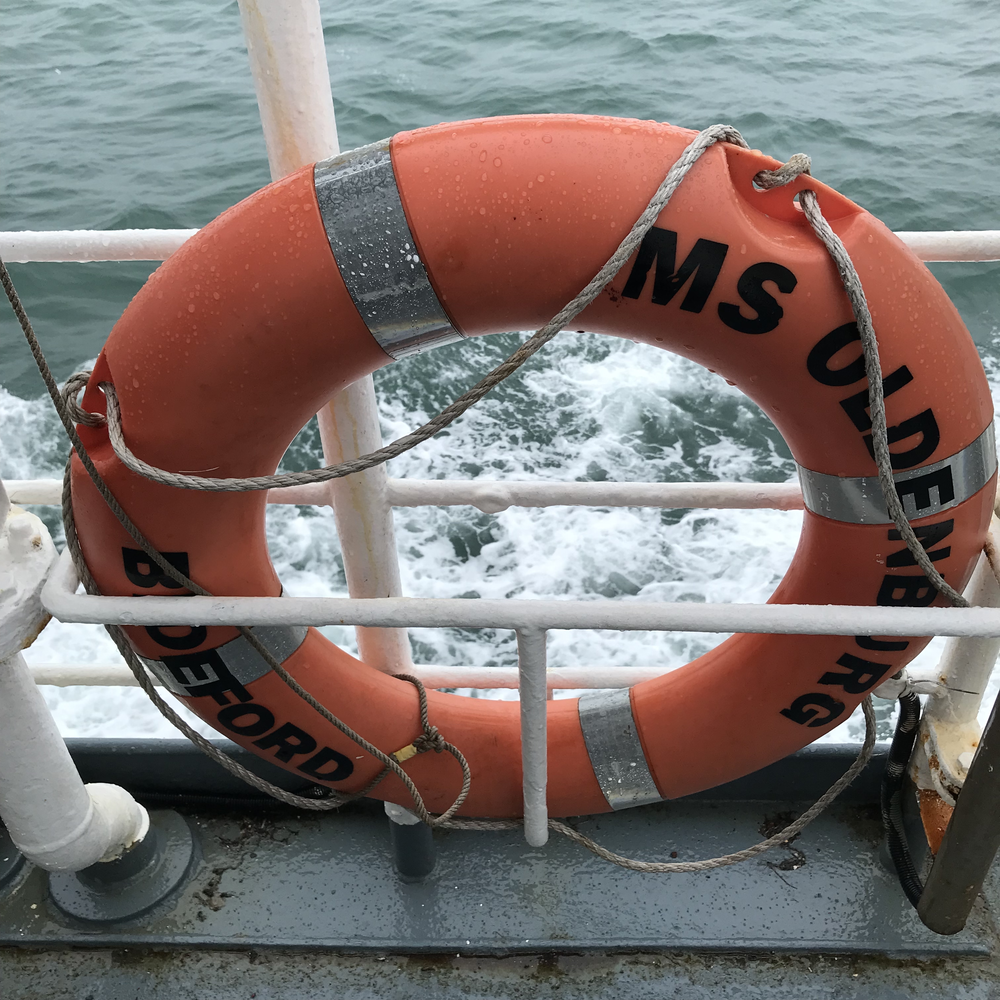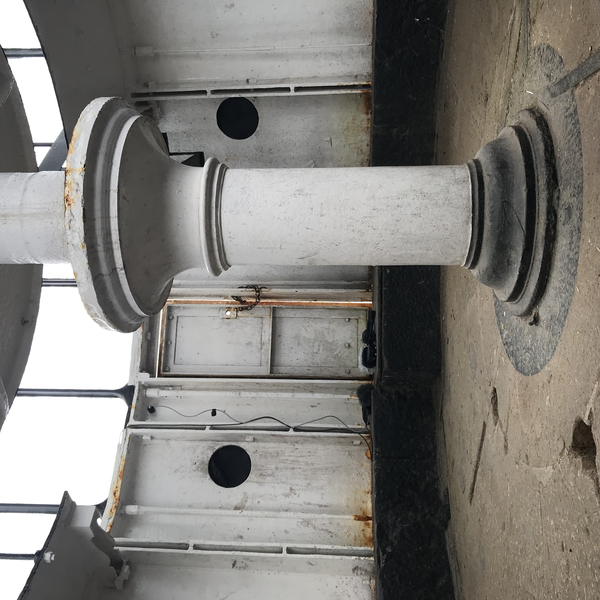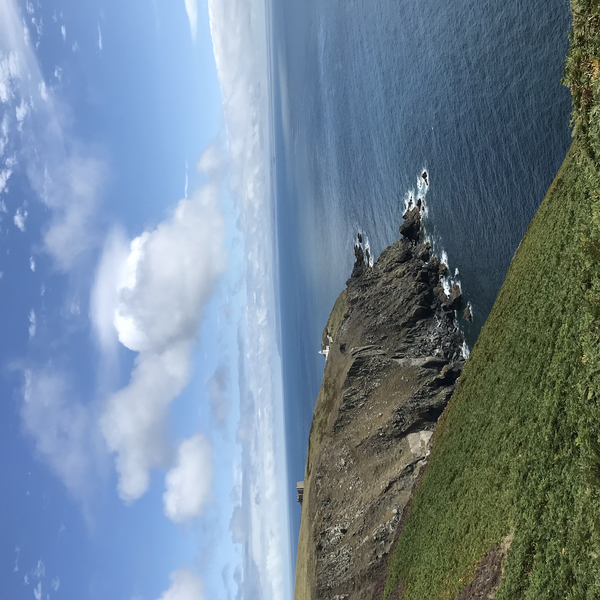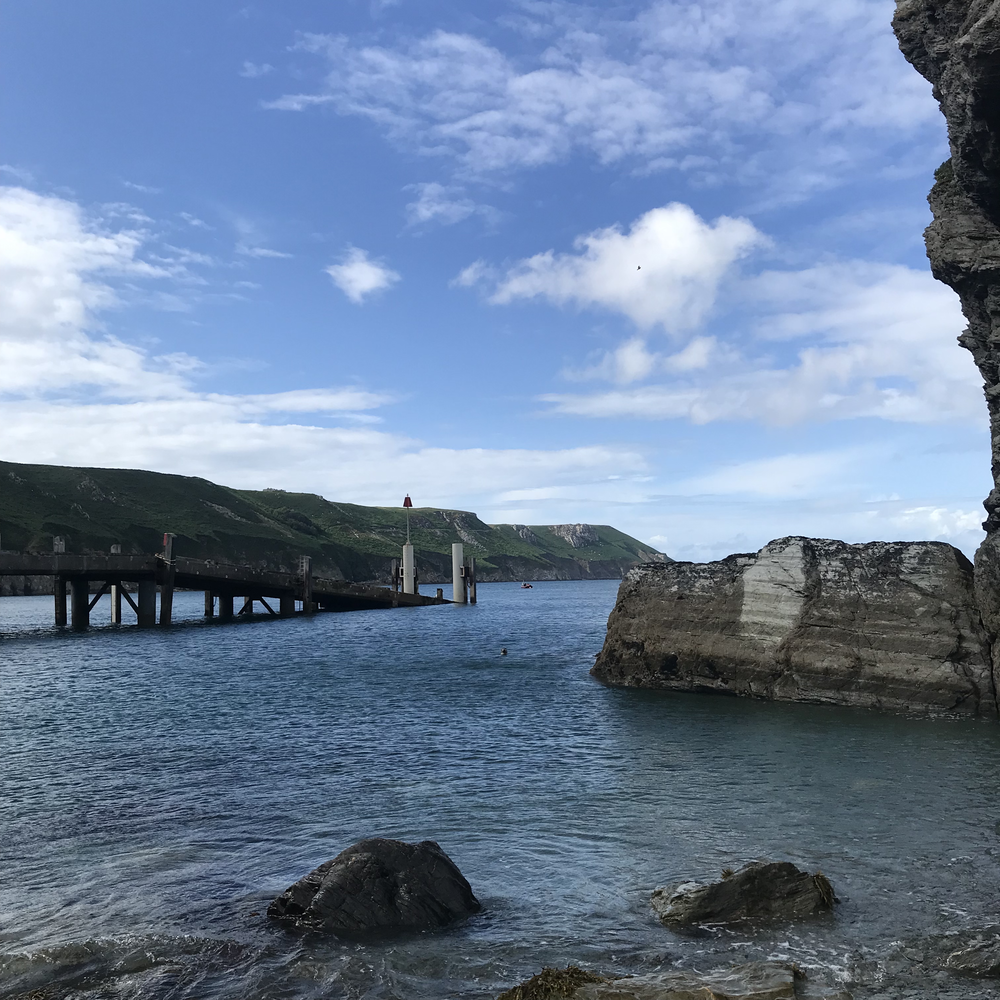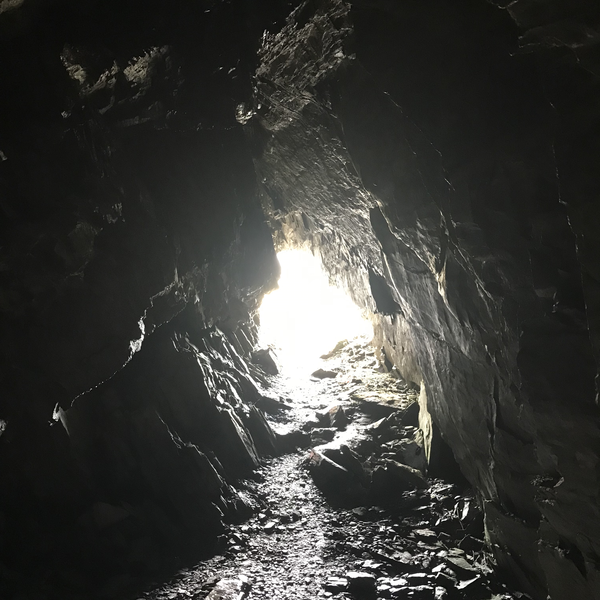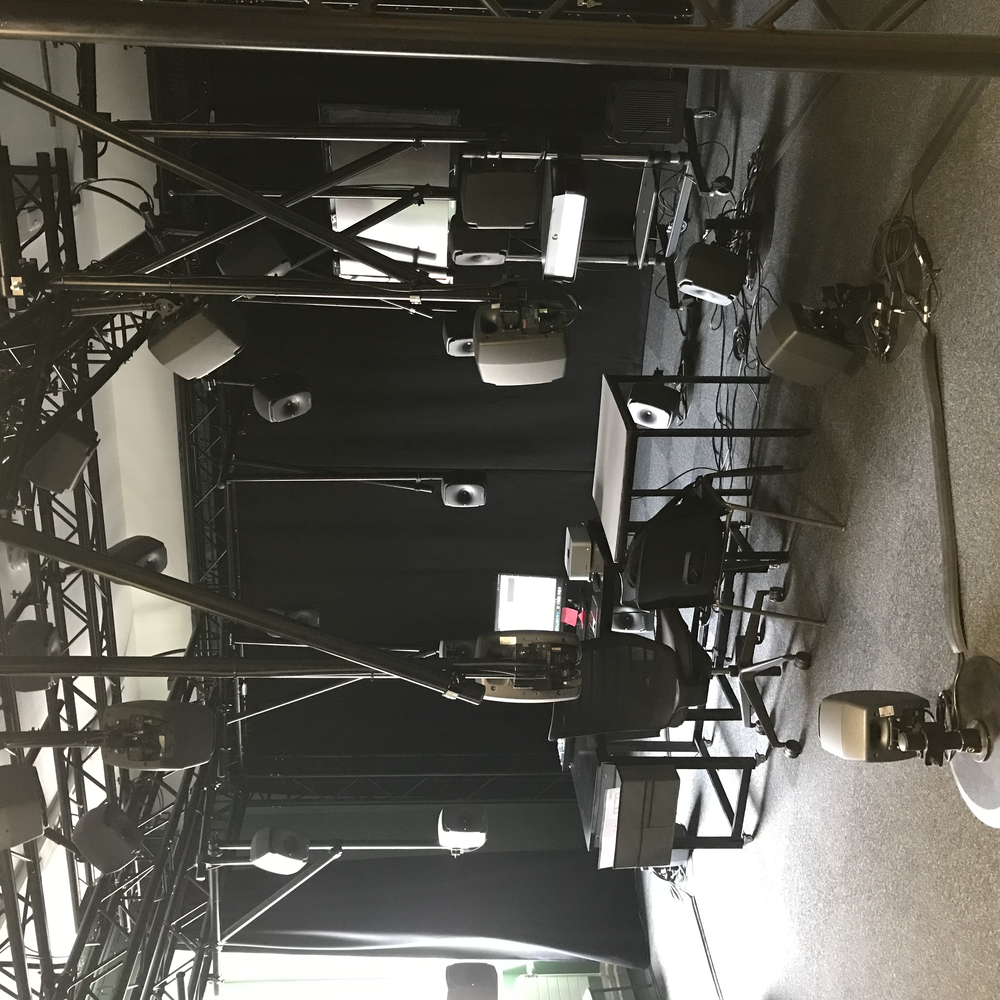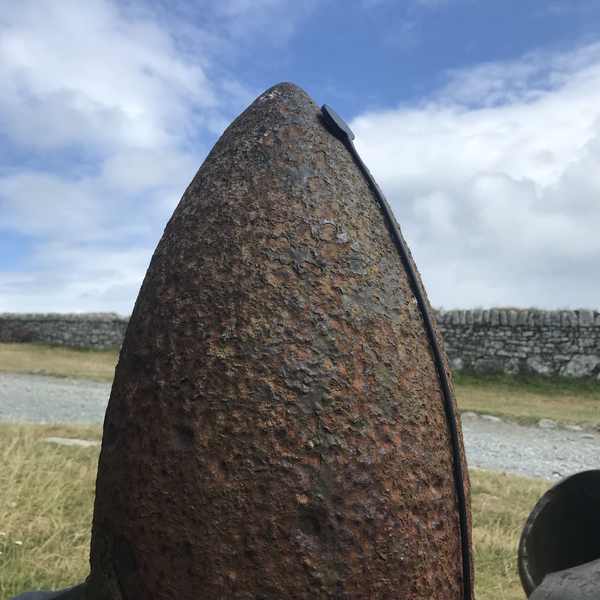Day 4: Flag at Half Mast, Harbour at Low Tide and an Encounter with the Wind: 20/07/25
Day 4 started with a gentle wind rolling off the Atlantic, so I explored how to capture wind through objects. I started with a corrugated iron barn, using the geophone with the magnet attachment, and moved on to a long wire fence that led from the farm buildings, arching over to the cliff path, presumably to keep the grazing livestock away from the village.
The wind calmed a bit, and we spent the afternoon exploring the harbour at low tide. The warden requested that we time our trip so as not to disturb the removal of the body of the visitor who passed away the day before. So, we sat on the clifftop and recorded the sound of the flagpole, with the Union Flag at half-mast.
After the lifeboat collecting the body had departed, we walked down to the harbour and set about recording waves, rockpools, and the subtle interplay between waves and the harbour jetty, all the while being watched by a solitary grey seal.
Later that evening, the wind picked up again, and I recorded its resonance as it wrapped itself around the decommissioned lighthouse in the centre of the island.
Later that evening, after nightfall, I set out again to record the incoming Manx Shearwaters for one last time. This time, I employed the highly sensitive mini DPA microphones spaced at about 20cm in an A/B position on a piece of wire. As days go this was perhaps the most productive and varied.
Day 6: The Departure: 22/07/25
Departure day means packing down the tents, ready for packing into the ferry crates by 10 a.m. The ferry arrives at 12 and leaves at 4 p.m. So today is a quiet day on the recording front, with just a few quick recordings and a gentle walk before lunch. Gladly, the weather is better than on the day of our arrival, which meant a calm and sunny crossing for Devon. We arrived back in Ilfracombe just after 6 pm and pitched up at a local campsite overlooking the Bristol Channel.
Day 2: Wild Atlantic Coast and Long Horned Cows: 18/07/25
On day two we set off for a walk to the end of the island. Lundy is only 3 miles by 1/2 a mile, so walking is easy. The harbour and village sits at the south end of the island and walking out towards the north along a farm track takes you through fields and heathland. On the way we encounter rough haired Soay sheep, the most primitive sheep breed in Europe, and Highland Cattle. The cattle are especially docile and despite their enormous horns give off a sense of calm with their long fringes and rhythmic munching of grassland. We also encounter goats high up on the clifftops, looking out to sea, dreaming of who know what. Occasionally we catch a glimpse of what might be puffins, although we are a little late in the year to experience the brooding colonies that regularly visit the islands north shore cliffs in the summer.
We find a perch on the Atlantic shoreline for lunch and test out the geophone before walking on to the north lighthouse. Both working lighthouses are now automated with a third and oldest inland lighthouse which sits just outside of the village is now decommissioned and can be visited at any time of day. We visited the lighthouse to experiment with its amazing reverb and try out some quick percussive experiments. We return to this lighthouse on day 4 for a completely different sonic encounter.
On our walk back we chat to a bird watcher observing a group of snorkelers swimming with seals in the bay below. She asks us what we’re up to and I explain that we’re field recording and generally searching for what ever sounds present themselves. She advises that we go out in the dead of night and record the song of the nocturnal Manx Shearwaters, that roost in abandoned rabbit warrens. The Manx sound like manic laughing chickens and as we later found out will only visit the island, after a day collecting food for their chicks, after dark and the darker the better.
We sit for a while and record the seals singing down in the bay before returning for dinner. So far, my approach/methodology of just exploring and seeing what the island offers in the way of sonic encounters seems to be paying off and I’m slowly getting to grips with recording set ups and techniques.
Later that evening we find a clifftop just below the castle and wait for nightfall. Slowly but surely, we start to hear the Manx coming in. the odd faint cry here and there building to a cacophony of rhythmical screeches that really are otherworldly. On the walk back to the campsite in total darkness it becomes clear that the Manx are everywhere. The seem to be very close to where we are walking, so much so that I’m concerned that we might accidentally disturb a nest.
Day 1: The Arrival: 17/07/25
The arrival. Having a 5-hour drive from the Midlands to Ilfracombe in North Devon, we spent the night in a B&B close to the harbour, ready for a 9 am boarding the next morning. Setting off at 10 am, the rumbling diesel engines began to quicken until finding a steady rhythm as we left the harbour out into the Bristol Channel. The crossing can be notoriously choppy, and today seemed true to form. We both suffered a slight seasickness, but nothing too horrific.
As far as field recording, the most I could manage on the crossing was to experiment with the magnetic geophone on the ship's metal hull. Strange as it may seem, monitoring this experiment through headphones somehow eased my churning stomach. The lower deck included a party of children, each coping in their own way with the swaying and pitching of the MS Oldenberg. The ship was commissioned in 1958; a detailed history can be found here - https://www.landmarktrust.org.uk/lundyisland/ms-oldenburg/history/.
Once landed, there is a steep and steady climb of about a mile from the harbour to the village. The ship carries a handful of staying visitors, many day trippers, and the island’s food and drink supplies. There is a hive of activity with tractors and Land Rovers employed to move boxes of supplies and visitor luggage from the harbour to the village and the various outlying buildings across the island. Our luggage, including tents, was not due to arrive on site till 4 pm, so we checked into the pub for a bite to eat before pitching our tents and heading off for an evening walk. The aim of today was simply to arrive and scope out some possible field recording sites before getting settled in. After a far too significant a portion of nachos in the pub, we settled in for an early night, and for me, the chance to test a new tent, an MSR Elixir 2.
Day 3: Exploring The Harbour: 19/07/25
The harbour at high tide was our playground today. We experimented with recording seascapes using a combination of hydrophone, geophone, and X/Y microphones. We also swam in the clear, warm harbour waters. The geology is mostly grey granite stone on this side of the island, giving a uniform grey-blue hue topped by lush green vegetation. The local seals perfectly match this grey dappled landscape, occasionally watching us from a safe distance.
I have an allergy to fish, both eating and coming into contact with fish, as a child, which brought me out in hives and made me physically sick. As an adult, I'm now vegan, partly due to allergies to dairy products, but also for ethical and political reasons. Swimming in the sea, something I've not done for over 20 years, also triggered an allergic reaction. My skin was covered in hives, and after a quick internet search, it turned out to be a likely reaction to tiny, microscopic parasites which drift in the sea looking for fish to attach to.
The rest of the day was spent gently wandering around the harbour area and the south of the island, gathering sounds as they presented themselves.
I can feel myself begging to accept the rhythms of the island, the sea, its wild inhabitants and undulating landscape as if caught in a spell. My strategy for just seeing what the island offers and following my nose seems to be working. Although it’s hard not to be conscious of time and the need to ‘collect’ or ‘glean’ sounds to work with and resist a more extractive urgency. I have to learn to give myself up to the landscape in the moment of encounter. It invites a post-capitalist flow states which match the contours of the space, the fact that we are remote, if only a few miles and a 15-minute helicopter ride from the mainland, in what to be honest is now very much a tourist destination but also a wildlife haven. Perhaps this is just a different kind of capitalism and exclusive tourism, but looking into the history of the island and its past utopian ideals, and the fact that, in the scheme of current capitalist structures, there is a payoff between the preservation of wildlife and tourism. Either way, it’s hard not to get caught up in the island’s charms.
I guess this is the spell of romanticism, which is caught up in the spectacle of late capitalism. Landscapes become ‘protected’ from the ravages of extractivist capitalism only by becoming part of an exclusive tourist destination overseen by organisations that, although dedicated to the protection of historic spaces, landscapes, habitats, and buildings, are still captured within the very exclusivity which allows them to exist. There is an argument that such preservation strategies create exclusively middle-class, white spaces, which is perhaps a quirk of the UK and its colonial histories. The very fact that I was granted the privilege to visit the island as part of an Arts Council grant speaks volumes.
Today’s exploration of the island was interrupted by the tragic death of a day visitor. Suddenly, there was a hive of activity, including the arrival of a coastguard helicopter, and a general air of concern. Snippets of overheard conversation in the pub that night suggested that a walker had had a suspected heart attack and that his now widow was being looked after in the manor house overnight.
Day 5: In Search of Seals and Wind and the Lighthouse 21/07/25
We set off to explore the island's north again today, armed with some local knowledge, searching for seals. The seal colonies around the island are curious, and we had been advised to visit a specific cove, where it was safe to swim amongst the seals. As we set out, the rain slowly set in, and by the time we had circled round to the bay, we decided it was too slippery to attempt the scramble down to the water. We strolled back to the village along a coastal cliff walk and saw and heard several groups of seals, albeit from a distance. We managed to get back just in time for lunch at the bub, sadly without being able to swim because of the conditions, but glad we’d found the coastal path and explored another bit of the island.
Later that evening, the wind picked up again, and I recorded its resonance as it wrapped itself around the decommissioned lighthouse in the centre of the island. I also recorded the wind from within the church.
I employed the DPA microphones, the geophone and contact microphone, as well as the Zoom H6 onboard X/Y microphones and the Tascam built-in microphones positioned at A/B at the top of the spiral staircase. The wind slowly began to resonate the metal structure of the lantern room. The experience of being in such a resonant space in windy conditions was incredible and a bit of a sensory overload. I imagined what it might be like to play instruments within the space as the wind resonated from outside, and what a human/elemental composition/performance/improvisation might unfold.
After nightfall, I set out again to record the incoming Manx Shearwaters for one last time. This time, I employed the highly sensitive mini DPA microphones spaced at about 20cm in an A/B position on a piece of wire. The Manx are invisible in the darkness and from the occasional burst of song build into a cacophony of noise which seems to surround you. On the walk back, I was greeted by the herd of deer that live on the island, who were extremely close, as if I could reach out and touch them, but virtually invisible apart from their glowing eyes. As days go this was perhaps the most productive and varied.
In The Studio:
Post Lundy, I spent some time in my home studio using the ambisonic plugins and workflows provided by The Sound and Image Research Centre, using binaural decoding. Over the summer, I then took two compositions into the Spatial Audio Studio at the University of Greenwich.
The studio consists of a 36-speaker array positioned to make a sphere or bubble of sound with the mixing station in the centre. The speakers are positioned top (directly above the mixing station) = 1, then moving clockwise from centre at ceiling height, head height, mid, and floor height. The system also contains 4 floor-mounted sub-bass speakers.
Two pieces came from the Lundy research trip: Lighthouse and Water-Water. Lighthouse lends itself to a live performance work with improvised instrumental accompaniment.
Water-Water seems to suggest it wants to be an installation piece.
The plan is to work on the projects from home, subject to funding, with a view to testing them with audiences in 2026.
I later had the opportunity to test the compositions in the studio, experimenting with various plugins and compositional techniques under the guidance of Brona Martin.
Resources and Further Information:
Lundy Films
https://www.youtube.com/watch?app=desktop&v=MKqQ0er8tL8
https://www.youtube.com/watch?v=71cBait5f6E
https://www.youtube.com/watch?v=ipUoRpVK32s
Reaper basics
https://www.youtube.com/watch?v=NLVMcmvORoA
Music and Compositional Films - R. Murray Schafer:
https://www.youtube.com/watch?v=GiOhtgR1T0k&t=255s
https://www.youtube.com/watch?v=im8BtWPeCWU
https://www.youtube.com/watch?v=JX9VzICmKpA
Websites and Organisations:
